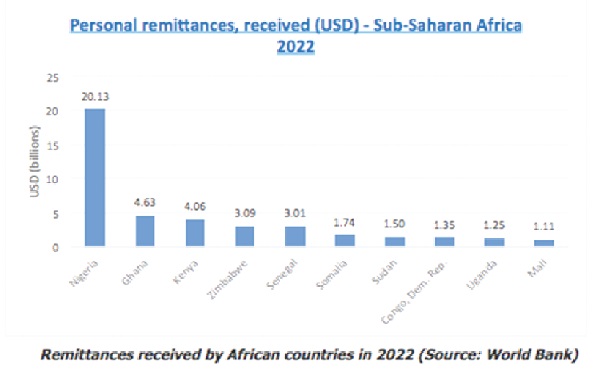
Balance of payments and inward remittances compilation and analysis: Case of Ghana from 2016 to 2022
This is the concluding part of the article which was first published last Tuesday 20th August 2024 edition of the Daily Graphic.
These transfers may happen through more formal channels like electronic recordable systems, or through informal channels, such as the help of trustworthy friends that carry cash from the senders to the receiving families.
Despite the large interest in remittances from monetary institutions, the problem of the reliability of data is still evident, such that the gap between the amounts sent and received has been growing in recent years, proving the strong inconsistency of remittances data.
BOP account definitions of remittances are somewhat broader than those resulting from movement of persons because they are not based on the concepts of migration, employment or family relationships.
They consist of funds and non-cash items sent by individuals who have migrated to a new economy and become residents there as well as the net compensation of border, seasonal or other short-term workers who are employed in an economy in which they are not resident.
Remittances could also be compensation of workers employed by non-resident employers in the home country of origin.
According to Levitt (1998), remittances are not only money but ideas, identities, practices, and social capital that flow from receiving to sending countries.
They make up a significant part of international capital flows in a country and could be a life wire to the beneficiaries who often need it for their sustenance. International remittances are cross-border earnings, goods, or funds transferred by migrants to their relatives, friends or acquaintances in their home countries.
They represent household income from foreign economies arising mainly from the temporary or permanent movement of people to those economies. Remittances are an integral part of one of the ma- jor macroeconomic accounts called the Balance of Payment (BOP).
The BOP is an account that records transactions between residents of a country with resi- dents of other countries. The main factor that determines if a transaction is captured in the BOP is the issue of residency. If it is established that the transaction is between a resident and a non-resident, then the transaction is recorded in the BOP.
The BOP is divided into three different accounts namely the current, capi- tal and financial accounts. The current account records import and export of goods and services between residents and non-residents.
Balance of payments effect of remittances
The impact of remittances on private consumption, saving and investments is only part of the story about the contribution of remittances to the growth and development of source countries.
Remittances are an addition not only to the domestic household income but also to the receipt side of the balance of pay- ments.
Remittances offset chronic balance of payments deficits, by reducing the shortage of foreign exchange. These transfers can help to ease the often crucial restraint imposed on the economic development of the migrants’ home countries by balance of payments deficits.
They have a more positive impact on the balance of payments than other monetary inflows (such as financial aid, direct investment or loans), because their use is not tied to particular investment projects with high import content, bear no interest and do not have to be repaid.
In addition, remittances are a much more stable source of foreign exchange than other private capital flows and for certain countries they exhibit an anti-cyclical character.
Developing countries quickly recognised this obvious and clearly es- timable positive balance of payments effect of remittances, and measures were taken to increase such inflows of foreign exchange.
But such measures must be implemented with care, because apart from the positive balance of payments effects, remittances have an impact on the economic activity in the home country.
Depending on how they are spent or invested, their effects on production, inflation and imports will be different. A crucial factor in this respect is the extent to which the additional demand induced by remittances can be met by expanding domestic output.
The flexibility with which domestic supply reacts to extra demand will determine whether remittances will have positive employment effects or adverse inflation effects, and whether additional imports will be necessary. One of the negative effects of remittances on the current account is the “boome- rang effect”.
This occurs when remittances induce an increase of imports and trade balance deficits in the remittance-receiving country. However, most scholars disagree that it is the remittance-induced imports that cause these trade balance problems.
The propensity to import can also increase as a consequence of the general development of the economy, of a structural change in the pro- duction of consumer or investment goods, or of the international division of labour.
Another negative effect can be produced where remittances generate demand greater than the economy’s capacity to produce. When this demand falls on tradable goods, remittances can induce an appreciation of the real exchange rate.
The overvalued exchange rate reduces the competitiveness of the domestic industries in the foreign markets (by expensive exports), in the home markets (by cheap imports), and shifts resources from the tradable sector into the non-tradable sector, so-called Dutch Disease effect. This may further lead to balance of payments pressure, a slower growth of employment opportunities, and consequently to a further increase in the incentive to emigrate.
A possible reason for an insignificant Dutch disease effect of remittances is that the additional import of cheap capital goods may increase productivity and therefore improve the competitiveness of domestic products.
Moreover, the imported capital goods may be used to substitute other imports and/or to produce exportable goods. Further, in a system based on non-convertible domestic currency, the privilege of holding foreign currency in corroboration with inflationary tensions may have adverse consequences in monetary terms.